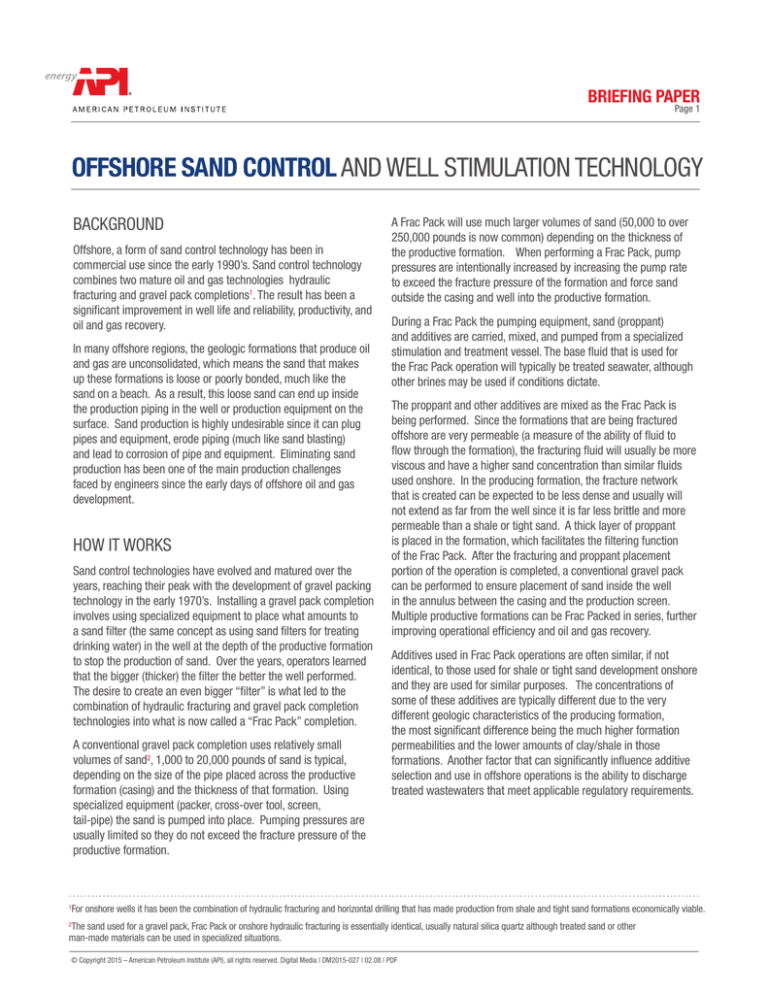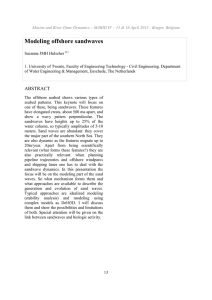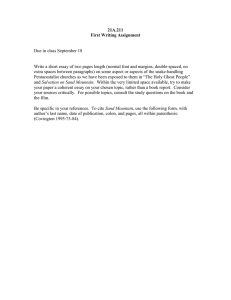
BRIEFING PAPER
Page 1
OFFSHORE SAND CONTROL AND WELL STIMULATION TECHNOLOGY
BACKGROUND
Offshore, a form of sand control technology has been in
commercial use since the early 1990’s. Sand control technology
combines two mature oil and gas technologies ­hydraulic
fracturing and gravel pack completions1. The result has been a
significant improvement in well life and reliability, productivity, and
oil and gas recovery.
In many offshore regions, the geologic formations that produce oil
and gas are unconsolidated, which means the sand that makes
up these formations is loose or poorly bonded, much like the
sand on a beach. As a result, this loose sand can end up inside
the production piping in the well or production equipment on the
surface. Sand production is highly undesirable since it can plug
pipes and equipment, erode piping (much like sand blasting)
and lead to corrosion of pipe and equipment. Eliminating sand
production has been one of the main production challenges
faced by engineers since the early days of offshore oil and gas
development.
HOW IT WORKS
Sand control technologies have evolved and matured over the
years, reaching their peak with the development of gravel packing
technology in the early 1970’s. Installing a gravel pack completion
involves using specialized equipment to place what amounts to
a sand filter (the same concept as using sand filters for treating
drinking water) in the well at the depth of the productive formation
to stop the production of sand. Over the years, operators learned
that the bigger (thicker) the filter the better the well performed.
The desire to create an even bigger “filter” is what led to the
combination of hydraulic fracturing and gravel pack completion
technologies into what is now called a “Frac Pack” completion.
A conventional gravel pack completion uses relatively small
volumes of sand2, 1,000 to 20,000 pounds of sand is typical,
depending on the size of the pipe placed across the productive
formation (casing) and the thickness of that formation. Using
specialized equipment (packer, cross-over tool, screen,
tail-pipe) the sand is pumped into place. Pumping pressures are
usually limited so they do not exceed the fracture pressure of the
productive formation.
A Frac Pack will use much larger volumes of sand (50,000 to over
250,000 pounds is now common) depending on the thickness of
the productive formation. When performing a Frac Pack, pump
pressures are intentionally increased by increasing the pump rate
to exceed the fracture pressure of the formation and force sand
outside the casing and well into the productive formation.
During a Frac Pack the pumping equipment, sand (proppant)
and additives are carried, mixed, and pumped from a specialized
stimulation and treatment vessel. The base fluid that is used for
the Frac Pack operation will typically be treated seawater, although
other brines may be used if conditions dictate.
The proppant and other additives are mixed as the Frac Pack is
being performed. Since the formations that are being fractured
offshore are very permeable (a measure of the ability of fluid to
flow through the formation), the fracturing fluid will usually be more
viscous and have a higher sand concentration than similar fluids
used onshore. In the producing formation, the fracture network
that is created can be expected to be less dense and usually will
not extend as far from the well since it is far less brittle and more
permeable than a shale or tight sand. A thick layer of proppant
is placed in the formation, which facilitates the filtering function
of the Frac Pack. After the fracturing and proppant placement
portion of the operation is completed, a conventional gravel pack
can be performed to ensure placement of sand inside the well
in the annulus between the casing and the production screen.
Multiple productive formations can be Frac Packed in series, further
improving operational efficiency and oil and gas recovery.
Additives used in Frac Pack operations are often similar, if not
identical, to those used for shale or tight sand development onshore
and they are used for similar purposes. The concentrations of
some of these additives are typically different due to the very
different geologic characteristics of the producing formation,
the most significant difference being the much higher formation
permeabilities and the lower amounts of clay/shale in those
formations. Another factor that can significantly influence additive
selection and use in offshore operations is the ability to discharge
treated wastewaters that meet applicable regulatory requirements.
For onshore wells it has been the combination of hydraulic fracturing and horizontal drilling that has made production from shale and tight sand formations economically viable.
1
The sand used for a gravel pack, Frac Pack or onshore hydraulic fracturing is essentially identical, usually natural silica quartz although treated sand or other
man-made materials can be used in specialized situations.
2
© Copyright 2015 – American Petroleum Institute (API), all rights reserved. Digital Media | DM2015-027 | 02.08 | PDF
BRIEFING PAPER
Page 2
OFFSHORE SAND CONTROL AND WELL STIMULATION TECHNOLOGY
REGULATION
Offshore, the primary regulatory authority is the Department of
Interior’s Bureau of Safety and Environmental Enforcement
(DOI-BSEE). DOI-BSEE is responsible for approving well designs,
drilling procedures, well completion plans and procedures and
most aspects of production operations. The Environmental
Protection Agency (EPA) holds responsibility for managing
discharges from offshore facilities. Discharges are managed
under the Clean Water Act and its National Pollutant Discharge
Elimination System (NPDES) permit program.
The ability to discharge recovered fluids from Frac Pack operations
offshore is an important logistical consideration. The NPDES
permits issued by the EPA for the offshore oil and gas industry
have strict discharge limits and monitoring requirements for many
categories of discharges, including “well treatment fluids” and
“produced water.” Well treatment fluids include fluids recovered
from Frac Pack operations and produced water (natural formation
water from the producing formation) can include produced water
mixed with treatment fluids.
Permit limits applicable to these discharge categories
include:
•
•
•
•
•
Prohibition of discharges of listed priority pollutants
(other than trace amounts),
No free oil (no sheen),
Daily maximum and monthly average limits on the oil
content of the discharge,
Discharge volume reporting, and
Toxicity limit if the treatment fluid is mixed with
produced water.
These performance based limits provide strict controls on the
fluids that are discharged and ensure a sound,
risk-based approach to protecting the environment.
If the recovered treatment fluid cannot meet the NPDES permit
limits, this fluid would be sent to shore for disposal in deep
injection wells that are permitted under the Safe Drinking Water
Act and managed by the respective states where the injection
would occur (authority delegated to the state once the state
program is found to satisfy federal requirements). The injection
wells are operated as Class II wells under the EPA’s Injection
Control Program.
© Copyright 2015 – American Petroleum Institute (API), all rights reserved. Digital Media | DM2015-027 | 02.08 | PDF
Class II wells are specifically designed to ensure protection of
groundwater, isolation of injected fluids, are monitored to ensure
the integrity of the well and the geologic formation into which the
fluid is injected at all times, and to document the sources and
volumes of fluids that are injected.
SUMMARY
Frac Pack operations offshore have a robust record of flawless
performance. In the U.S., all oil and gas well completion
operations, including Frac Pack are managed by the DOI – BSEE
and most environmental issues relevant to Frac Pack are managed
by the EPA. The operational and environmental aspects of these
operations receive significant scrutiny by these agencies and are
supported by strong operational management practices used by
operators.






